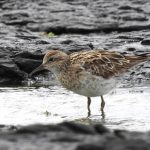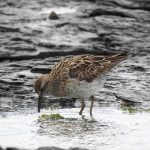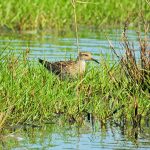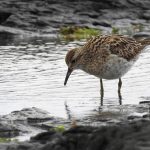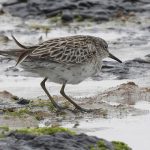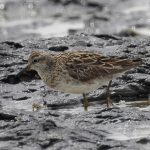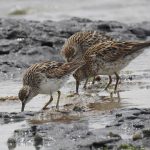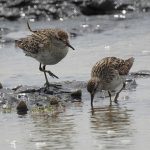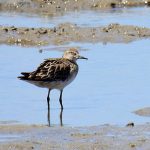SHARP-TAILED SANDPIPER
Imagine embarking on a journey that stretches over thousands of kilometers, crossing vast oceans and continents. This is the annual voyage of the Sharp-tailed Sandpiper, a small, yet intrepid bird that breeds in the tundra of Siberia. As the northern summer wanes, these birds set off on an incredible migration to the southern hemisphere, with Australia being one of their key destinations.
Upon arrival in Australia, typically around September, these sandpipers disperse widely, seeking out wetlands, estuaries, and sometimes even flooded fields across much of the country. They are most commonly found in the south-eastern regions, including Tasmania, but sightings can occur almost anywhere there’s suitable habitat.
The Sharp-tailed Sandpiper is a forager, its diet mainly consisting of insects, small crustaceans, and occasionally seeds. With a keen eye and a swift, probing beak, it sifts through mud and shallow waters, a testament to its adaptability and survival skills.
Breeding for these sandpipers occurs far from Australian shores, in the remote tundra of Siberia. There, in the brief Arctic summer, they nest on the ground, laying clutches of eggs in shallow depressions. It’s a race against time as they must hatch and raise their young before the return of the harsh winter.
Despite their resilience, Sharp-tailed Sandpipers face numerous threats. Habitat loss due to wetland drainage and land development poses a significant challenge, both in their breeding and wintering grounds. Climate change also threatens to disrupt their migratory patterns and the delicate balance of the ecosystems they depend on.
One of the most captivating sights is a flock of Sharp-tailed Sandpipers in flight, moving as one, their wings whispering across the sky. They are a testament to the beauty and complexity of nature’s cycles, a reminder of the interconnectedness of our global ecosystems.
The journey and life of the Sharp-tailed Sandpiper underscore the importance of international cooperation in conservation efforts. Protecting wetlands and natural habitats is not just about saving a single species; it’s about preserving the intricate web of life that spans our planet.
An interesting tidbit about the Sharp-tailed Sandpiper is their social nature during migration. They often mingle with other wader species, showcasing the diversity and interconnectedness of our natural world. Observing these gatherings is a delight for birdwatchers and a vivid illustration of the richness of biodiversity.
The Sharp-tailed Sandpiper, with its epic migrations and resilience, is a symbol of nature’s wonders and challenges. As they grace the Australian landscape each year, they remind us of the beauty of our natural world and the critical need to protect it for generations to come.

